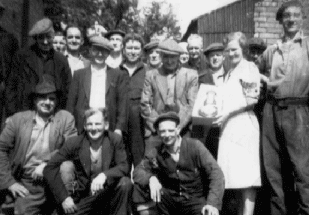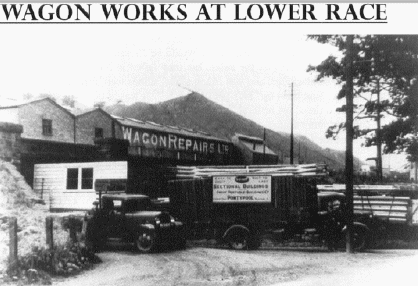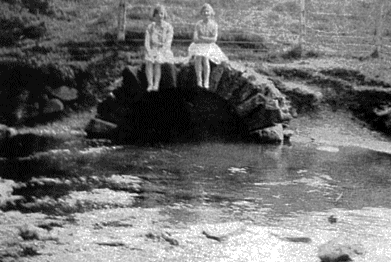PONTYPOOL GLYN PITS
Mynydd Maen Colliery
Situated near the remains of the old furnace Pontypool A drift mine opened c1912 to produce gas, steam, and house coals for the Mynydd Maen Colliery Company of Clarence street Pontypool.
In 1935 it employed 50 men on the surface and 100 men underground producing 50,000 tons of coal from the Meadow Vein (Yard Seven Feet) seam. On Nationalisation in 1947 it was placed in the National Coal Board's, South Western Division's no 6 (Monmouthshire Area) and at that time employed 47 men on the surface and 171 men underground working the Elled (Two Feet Nine) and Old Coal (Five-Feet / Gellideg) seams, it was then being worked along with the Elled Level. In its final year of production, 1954 it produced 7378 tons of coal, for the rest of the year it employed 3men on the surface and 10 men underground on pumping operations only.

Some of the staff that worked at Mynydd Maen Colliery

This second photograph was taken from where the bottom of the Race road joined the Albion road leading from Pontypool to Hafodyrynys. In the background can be seen the huge tip that contained the mine waste from the Mynydd Maen Colliery.
Photo no3 below shows us the village of Old Furnace. The trucks and engine in the picture passed over the bridge from where the lorries are passing under in the above photograph. For the benefit of the viewer, the village of Old Furnace is situated a quarter of a mile away just opposite the bottom of the waste tip.

Above is the village of Old furnace with the Mynydd Maen colliery situated 30 yards to the bottom right of this photograph. (out of sight)
Iron at the Old Furnace was being produced hundreds of years ago, and in fact, Oliver Cromwell’s troops in 1645 destroyed much of the iron-making capabilities here, but they were quickly restored and working once again.
The above photograph shows the remains of a furnace (coloured yellow) intact when this photo was taken circa the 1950s. The two buildings (with their roofs coloured blue) when removed exposed in their foundations the bases for the process of producing bars of pig iron. Most forges were converted to coal and coke, but here at Old furnace, the Trosnant forge may still have been using Charcoal into the 1800s. Transport for the pig iron produced here was by mule and packhorse to a place called Sow Hill at Brynwern near Pontypool and then to be forwarded to the local forges while the remainder went by canal to other parts of the world.

The water from the Glyn ponds fed the Trosnant furnaces and then emerged through the tunnel as seen in the photograph (near the workings). The next stage was to see the water passing under another nearby tunnel and on through to a water wheel, which in turn created power for the Mynydd Maen colliery needs. The water source then made its way under the collieries lamp room, and onward alongside the tramroad that led to the A472 main road, The water passed very near to the location shown in the photograph that shows the slag tip and the lorries moving under the bridge at the bottom of the Race road. The Trosnant brook fed numerous other industries on route to where it linked up with the Afon Llwyd near Pontymoile. In 1803 the Glyn Ponds was made larger by the Monmouthshire Canal Company in order to have enough water to maintain levels for their canals.